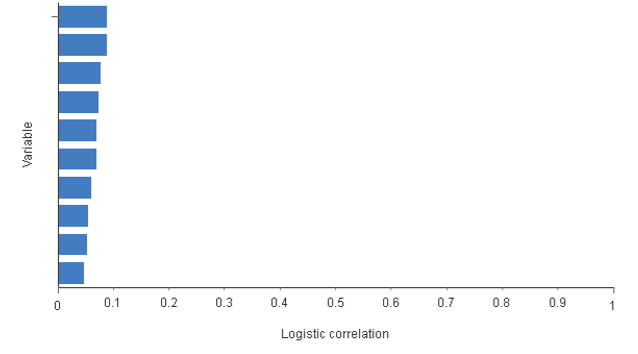By applying artificial intelligence, the churn ratio can be reduced while reducing costs. For that reason, we were contacted by a telecom company to develop a project to prevent customer churn.
Data set
Usually, in churn prevention cases, the number of clients that abandon your company (positives) is a lot lower than those who continue being your customers (negatives). But, unfortunately, that means the data is not well balanced, which can complicate the data analysis and make the predictive model tend to always predict negative results.
Given the complex nature of customer churn, we can assume that there is not just a single variable with a very high logistic correlation to our target.

As you can see from the graph above, none of the variables has more than 10% influence on churn decisions.
Data analysis
Our team studied different possibilities for this project. Still, the one which worked best was building our own predictive model and decreasing the negative effect of poorly balanced data sets on most models. Those models indicated a lot of precision and specificity; however, as it is not a balanced data set, they are not good indicators. Also, the sensitivity for models that do not take unbalanced data sets into account can be really poor.
On the other hand, Artelnics’ predictive model uses a self-developed algorithm that minimizes the weighted quadratic error. Using it, the problems associated with poorly balanced data sets get solved, as in this case.
| Classification test | |
|---|---|
| Precision | 67.80% |
| Error | 32.20% |
| Sensitivity | 74.47% |
| Specificity | 67.59% |
From this graph, you can see that our model has relatively low precision, which means some clients our model predicts will churn when in reality, they do not. However, knowing that the sensitivity is 75%, a low precision might indicate that high-risk customers who the model predictss as churn and do not abandon the compans.
The quality of the model can also be measured by calculating the area under the ROC curve. In this case, the area is 0.78, which indicates good performance.

Conclusions
Using our artificial intelligence technology in the telecom sector has a lot of benefits for companies, including churn prevention or customer targeting. With Artelnics technology, our customers can predict high-risk clients, generating more possibilities to stop that churn and continue developing benefits for the company.
As expressed before, stopping churn is very important because it generates direct and indirect costs while also denying every future possibility to obtain income from that customer.